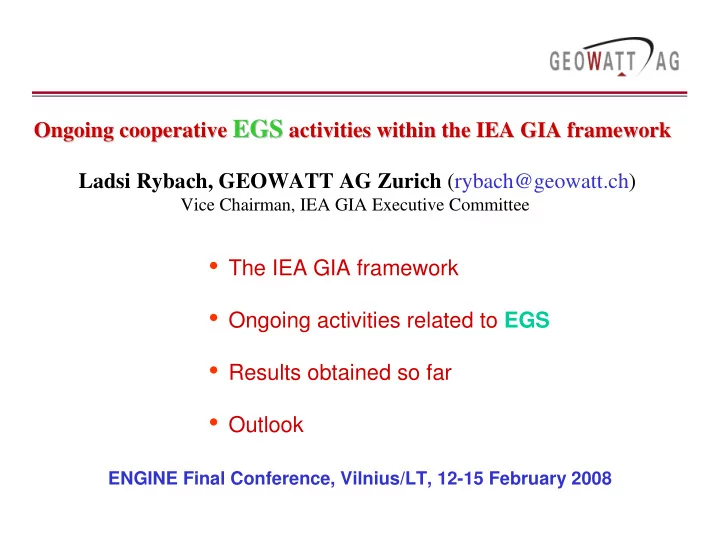

EGS activities within the IEA GIA framework Ongoing cooperative EGS activities within the IEA GIA framework Ongoing cooperative Ladsi Rybach, GEOWATT AG Zurich (rybach@geowatt.ch) Vice Chairman, IEA GIA Executive Committee • The IEA GIA framework • Ongoing activities related to EGS • Results obtained so far • Outlook ENGINE Final Conference, Vilnius/LT, 12-15 February 2008
IEA Geothermal Implementing Agreement (GIA) � Established in March 1997 � Provides flexible framework for international cooperation among national geothermal programmes for � Exploration � Development � Utilization � Members currently include: � 11 Countries: Australia, France, Germany, Iceland, Italy, Japan, Mexico, New Zealand, Republic of Korea, Switzerland and the United States � The EC � 3 Industry Members: Geodynamics, Green Rock Energy and ORMAT Technologies � Started 3 rd 5-year Term of operation in April 2007
Current GIA Research Studies now being conducted in four research areas, specified in four Annexes Annex I: Environmental Impacts of Geothermal Energy Development � Clearly identify possible environmental effects and devise and adopt methods to avoid or minimize their impact � Investigate impacts development on natural features � Study problems associated with discharge and reinjection � Examine methods impact mitigation and produce environmental manual � Investigate seismic risk from injection into enhanced geothermal system � Investigate sustainable utilization strategies
Current GIA Research Annex III: Enhanced Geothermal Systems (EGS) � Investigate new and improved technologies to stimulate geothermal resources to allow commercial heat extraction � Modify use of conventional and develop new geothermal technology to EGS � Collect information needed for decision making, design and realization of commercial EGS plant � Field studies of EGS reservoir performance
EGS in IEA GIA Annexes and Tasks With respect to EGS there are specific R&D activities, termed in the Annexes as Tasks: Annex I - Environmental Impacts of Geothermal Energy Development – Annex Leader: C. Bromley Task D: Seismic Risk of Fluid Injection into EGS (Task Leaders: R. Baria and D. Wyborn) Annex III - Enhanced Geothermal Systems (EGS) – Annex Leader: R. Baria Task A: Economic modelling (completed in 2001) Task B: Application of Conventional Geothermal Technology to EGS (Task Leader: J. Renner) Task C: Data Acquisition and Processing (Task Leader: T. Mégel) Task D: Reservoir Evaluation (Task Leader: D. Wyborn) Task E: Field Studies of EGS Reservoir Performance (Task Leaders: P. Rose, A. Genter) Activities relevant for EGS and ENGINE are also conducted in Annex VII: Advanced Geothermal Drilling.
IEA GIA results • In general, results and products of IEA GIA are accessible through its website www.iea-gia.org - in particular under www.iea-gia.org/activities.asp/ • Collaborative EGS R&D activities undertaken by the IEA GIA address the issue of induced seismicity, particularly in relation to engineered or artificially fractured geothermal reservoirs. • The focus for EGS is currently on the flourishing scene in Australia, where 6 companies are listed in the Australian Stock Exchange (ASX), 25 companies hold exploration rights over 170 licences, ranging in size from 120 to 12’000 km 2 .
Particular EGS results of IEA GIA (1) EGS economic modelling (completed) An economic model that allows the user to define the engineering and financial characteristics and the available geothermal resources of a proposed enhanced geothermal system project to determine the resulting economics and to optimize the plant configuration was completed in 2001 and is available for download on-line. Usefulness of the model has been demonstrated through extensive applications at Fenton Hill (USA), Soultz-sous-Forêts (France), and a site at Hunter Valley (Australia). The model operates on a PC in the Windows environment and is available at: http://web.mit.edu/hjherzog/www/ ; there go to go ONLINE DOCUMENTATION
Particular EGS results of IEA GIA (2) Further, recent EGS results can be found on http://www.iea-gia.org/publications.asp EGS induced seismicity The activities so far culminated in three international workshops, a “White paper” (IEA-GIA 2006), and a suggested Protocol (IEA-GIA, 2007). A website was established to record detailed results of the research (http://esd.lbl.gov/EGS/).
EGS induced seismicity - downloads “White paper”: Induced Seismicity Associated with Enhanced Geothermal Systems (Produced in association with Annex I research) To access, click: Induced Seismicity and EGS (doc, 1.2 MB) Draft - “Protocol for Induced Seismicity Associated with Enhanced Geothermal Systems” (Produced as part of the Annex I activities) To access, click: Draft Protocol (doc, 53 kB) Draft Report - Cooper Basin HDR Hazard Evaluation: Predictive Modelling of Local Stress Changes due to HFR Geothermal Energy Operations in South Australia To access, click: Draft Report- Cooper Basin Hazard Evaluation (pdf, 3.65 MB)
„White paper“
„Traffic light“ system M=3.7
„Protocol“ ____________ _____________________________
„Protocol“
Cooper Basin/Australia - EGS Seismic Risk Study Cooper Basin Seismic Risk Study on www.iea-gia.org
Methodology of seismic risk analysis
Table of EGS-related events
Identified fault segments, ready to shear
Seismic risk distribution around well Habanero-1
The EGS P M D A - a Geowatt AG product
OUTLOOK EGS R & D work will continue in the various Annexes and Tasks of IEA GIA; Hopefully the impressive EGS activities in Australia will trigger similar activities elsewhere; International cooperation in EGS is already significant and should be even more intensified. Prof. Dr. Dr.h.c. L. Rybach GEOWATT AG Zurich Dohlenweg 28 CH-8093 Zurich, Switzerland rybach@geowatt.ch
Recommend
More recommend